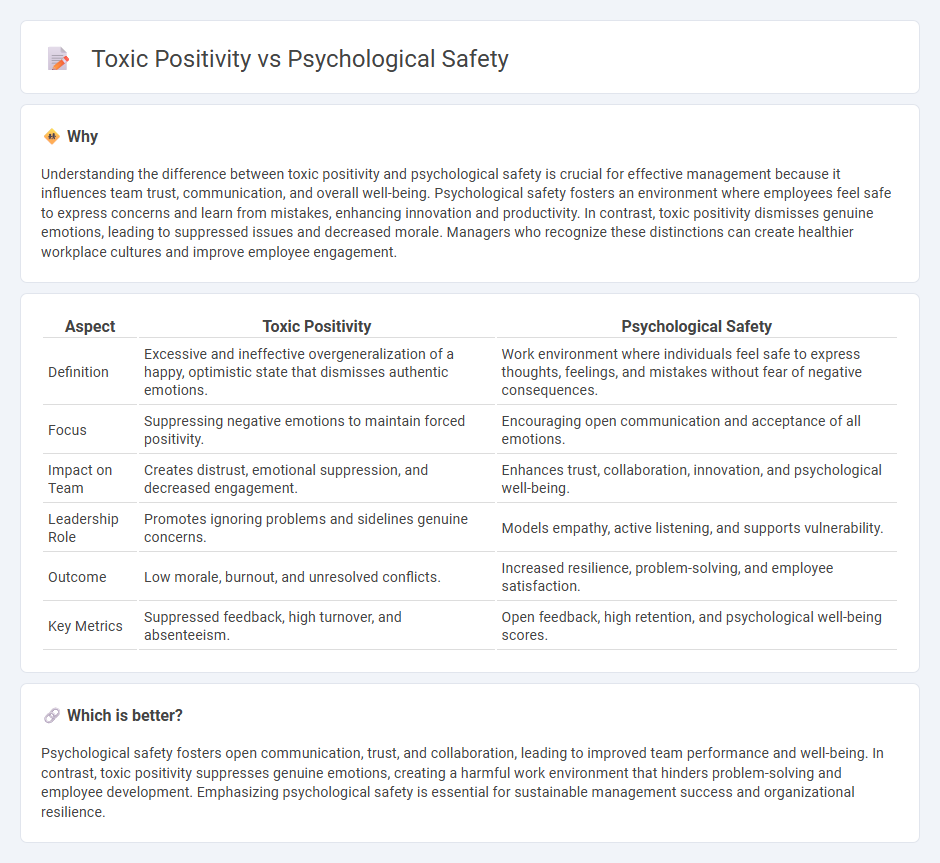
Management strategies that prioritize psychological safety create environments where employees feel secure to express concerns and innovate without fear of negative consequences. In contrast, toxic positivity dismisses genuine emotions by demanding constant optimism, undermining trust and open communication. Explore how embracing psychological safety improves team dynamics and organizational resilience.
Why it is important
Understanding the difference between toxic positivity and psychological safety is crucial for effective management because it influences team trust, communication, and overall well-being. Psychological safety fosters an environment where employees feel safe to express concerns and learn from mistakes, enhancing innovation and productivity. In contrast, toxic positivity dismisses genuine emotions, leading to suppressed issues and decreased morale. Managers who recognize these distinctions can create healthier workplace cultures and improve employee engagement.
Comparison Table
| Aspect | Toxic Positivity | Psychological Safety |
|---|---|---|
| Definition | Excessive and ineffective overgeneralization of a happy, optimistic state that dismisses authentic emotions. | Work environment where individuals feel safe to express thoughts, feelings, and mistakes without fear of negative consequences. |
| Focus | Suppressing negative emotions to maintain forced positivity. | Encouraging open communication and acceptance of all emotions. |
| Impact on Team | Creates distrust, emotional suppression, and decreased engagement. | Enhances trust, collaboration, innovation, and psychological well-being. |
| Leadership Role | Promotes ignoring problems and sidelines genuine concerns. | Models empathy, active listening, and supports vulnerability. |
| Outcome | Low morale, burnout, and unresolved conflicts. | Increased resilience, problem-solving, and employee satisfaction. |
| Key Metrics | Suppressed feedback, high turnover, and absenteeism. | Open feedback, high retention, and psychological well-being scores. |
Which is better?
Psychological safety fosters open communication, trust, and collaboration, leading to improved team performance and well-being. In contrast, toxic positivity suppresses genuine emotions, creating a harmful work environment that hinders problem-solving and employee development. Emphasizing psychological safety is essential for sustainable management success and organizational resilience.
Connection
Toxic positivity undermines psychological safety by discouraging authentic emotional expression and fostering an environment where employees feel compelled to suppress legitimate concerns. Psychological safety thrives when team members can share vulnerabilities and mistakes without fear of judgment, enabling open dialogue and trust. Organizations that recognize and mitigate toxic positivity cultivate a culture where psychological safety enhances collaboration, innovation, and overall well-being.
Key Terms
Trust
Psychological safety fosters a work environment where trust encourages open communication, vulnerability, and authentic expression without fear of judgment, promoting genuine emotional support. Toxic positivity, however, undermines trust by dismissing real feelings and enforcing a facade of constant optimism, leading to emotional suppression and disconnection. Explore how building true trust enhances psychological safety while avoiding the pitfalls of toxic positivity.
Authenticity
Authenticity in psychological safety fosters open communication, trust, and genuine emotional expression, contrasting with toxic positivity that suppresses real feelings through excessive optimism. Genuine psychological safety encourages acknowledging and validating diverse emotions, creating a supportive environment for growth and well-being. Explore how embracing authenticity can transform team dynamics and promote mental health.
Open Communication
Open communication fosters psychological safety by encouraging honest expression of thoughts and emotions without fear of judgment or retaliation. Toxic positivity undermines this environment by invalidating genuine feelings and promoting superficial optimism, which can stifle authentic dialogue. Explore effective strategies to cultivate true psychological safety through balanced communication.
Source and External Links
Psychological Safety at Work - Psychological safety is the belief that one will not be punished or humiliated for speaking up with ideas, questions, concerns, or mistakes, which fosters a work culture of learning, innovation, and well-being, and importantly links psychological and physical safety in the workplace.
Psychological Safety - Wikipedia - Psychological safety refers to team members' shared belief that they can take interpersonal risks without fear of negative consequences, enhancing team learning, performance, and workplace experience.
How to Build Psychological Safety in the Workplace | HBS Online - Establishing psychological safety involves openly prioritizing it, encouraging speaking up and risk-taking without fear of embarrassment, and overcoming internal impression management to create a culture where learning from mistakes is embraced.
 dowidth.com
dowidth.com